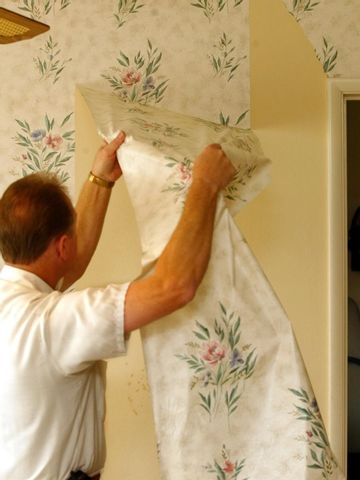How to Remove Wallpaper Without Going Bonkers

3:00 pm ET
July 26, 2016
Once upon a time, when your grandmother was in her prime and decorating her first home, wallpaper was all the rage. Wallpaper everywhere! It’s made the occasional resurgence since then, so perhaps you’ve still got rooms festooned with daffodil, elephant, or paisley prints right now (depending on the era of origin). Still, if you’re sick of the look, we’ll bet you’ve been wondering how to remove wallpaper without ruining your walls.
The first thing you should know is that removing wallpaper doesn’t have to be a headache. Depending on your wallpaper’s type, size, and age, your walls could be gloriously bare and ready for a new finish in about an hour if you’re lucky, or a day at worst.
Check out these steps to learn how to remove wallpaper without going crazy in the process.
Review the situation
If the wallpaper is newer, you’re in luck! You can simply strip the paper off the walls in big sheets with your bare hands, without having to use water or chemical products. Check by using a putty knife to pry the edge of the wall covering at a seam near the bottom of the wall. If it pulls away easily and keeps coming as you pull, congratulations! You’ll be done in no time. Continue stripping the wallpaper by hand.
“Wallpaper that was recently applied to primed walls may come off in large sheets,” says home decor expert Lauren Hufnagl. “Older wallpaper or wallpaper that was applied directly to plaster/drywall will be way more difficult to remove.”
So if the wallpaper is older and sticks stubbornly to the wall, plan on spending the rest of the day on the project.
Your next options, in order of ease, are spray-on water or commercial product and, for particularly tenacious wallpapers, rental of a wallpaper steamer.
Go shopping
Depending on the method of removal you select, tools and supplies you’ll need could include the following:
- Putty knife or broad knife, preferably both
- Spray bottle
- Rubber or plastic gloves, mask, and goggles
- Dropcloths
- Masking tape
- Wallpaper scorer, or an old fork if you don’t want to be that fancy
- Chemical stripper
- Rental steamer (last resort)
Prep the room
Remove wall hangings, pictures, switch plates, outlet covers, and anything else that might be clinging to the wall. If outlets are exposed, shut of electricity to the room where you’re working. Take as much furniture as you can out of the room, and cover what’s left with a dropcloth. It might get hot and steamy in there, and you don’t want anything to warp.
Next, spread plastic dropcloths over the floor and tape them along the baseboards (unless you want to remove the baseboards, which will be a lot more work for you). This is to make sure that the old glue, water, or the chemicals you use to remove the wallpaper won’t damage the baseboards or floor.
Score, mix, and soak
Using the scorer or the fork, scratch the wallpapered walls. Use a light touch and don’t get too energetic, though—you want to be very careful not to damage the drywall or plaster underneath. You’re doing this so the liquid you’ll use next can penetrate the wallpaper to its adhesive base.
Now prepare your soaking solution and pour it into a spray bottle. You can use hot water alone, or mix in a little fabric softener for added stripping power. Just make sure to mix the solution in small batches such as a few ounces so the water remains as hot as possible while you work. If you find you need something stronger, try a commercially prepared stripping solution.Now it’s time to saturate the wall. Spray a section that’s about 4 foot by 4 foot and let the liquid soak the paper. If you’re using water, wait about five minutes (or five to 15 minutes if you’re using a stripper; be sure to check the manufacturer’s directions). Just don’t let it sit much longer than that, because your walls could become a pulpy mess.
Time to strip
Once you’ve allowed the solution to soak, it’s time to start pulling the paper from the wall. It might not come off in clean strips, but a putty or broad knife should help you easily remove the more tenacious pieces.
“If you’ve tried these steps and it just isn’t happening, you may have to break out the big guns and rent a wallpaper steamer from your local hardware store, “says Hufnagl.
Steamers are a little like ironing your wall, and they produce a lot of heat, so it’s important to use gloves, open a window, and not press the steamer pad against the wall for too long. You just want to leave it there long enough to loosen the adhesive—about 30 to 40 seconds should be just right. Once the paper feels loose, you can use a putty knife to scrape the paper off the wall.
Now that your wall is free and clear of that old, dated wallpaper, it’s time to hang some more! Or paint, panel, or pad. But that’s a whole ’nother article. Good luck!
About the Business
Have a question? Ask the experts!
Send your question


